Even those who are new to classic men’s style can look sharp by relying on fundamental two-color pairings like navy and grey or blue and brown, with a suit in one solid color and a tie in another. But if you’re looking for ways to add more complexity to your ensembles, here are our tips on incorporating three or more colors into a single outfit (without looking like a peacock or a clown)!
- How to Use Three or More Colors Successfully in an Outfit
- 1. Change Up the White Shirt
- 2. Add a Vest or Waistcoat in a Bright Solid
- 3. Switch Out Your Suit for a Combination
- 4. Don’t Forget Your Feet
- 5. Add A Boutonniere
- 6. Add Several Colors at Once with Patterns
- A Note on Neutrals
- Conclusion
- Outfit Rundown
How to Use Three or More Colors Successfully in an Outfit
As a wardrobe develops, it’s easy to go for a solid worsted wool suit and a solid silk tie: it’s simple and straightforward, requiring little thought, and it looks good. Simply add a white shirt and brown or black oxfords, and you have a smart outfit that fits most professional workplaces and urban settings. However, the same few colors can get boring over time! So, here are six tips to add more color to your tailored style.
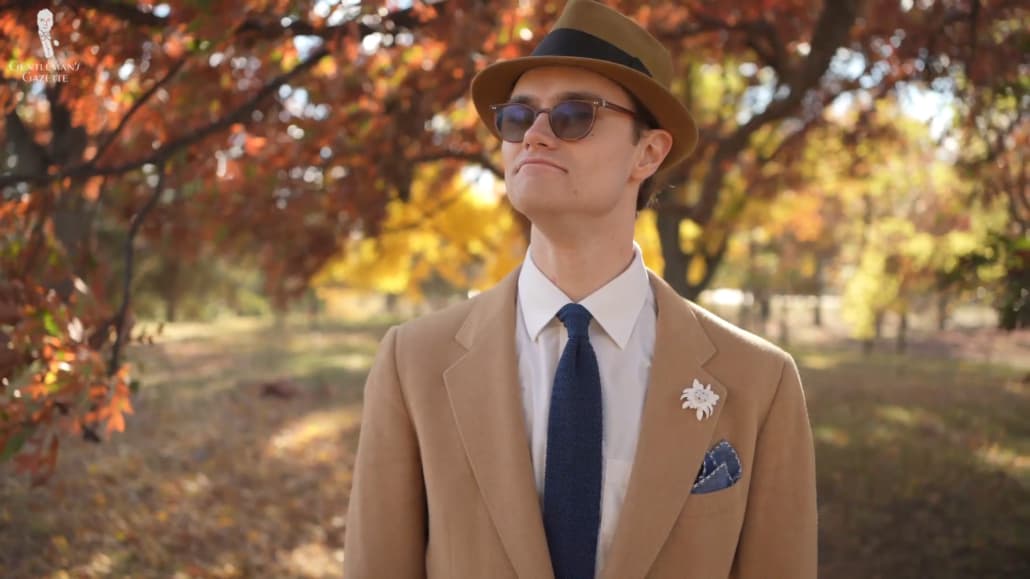
1. Change Up the White Shirt
While a white shirt can serve as a standard backdrop to your tie and jacket, it is just that–very standard. To go beyond basic, try a pastel blue shirt with a navy suit or a pink shirt with gray. You’re immediately adding a third color that also reduces the stark contrast that a white shirt can create.
To take it a step further, look for shirts in other pastel colors such a lavender, salmon, and pale green. They make excellent backdrops for the brighter versions of their colors – purple with lavender, orange with salmon, and hunter green with pale green. This subtle addition of color will help you tie together your other accessories.
2. Add a Vest or Waistcoat in a Bright Solid
Another easy way to add even more color to a suit is to put on a waistcoat or vest in a different, brighter color. Odd vests are expected to pop–even highly formal morning dress accommodates robin’s egg blue and buff waistcoats–so go bold with orange, red, royal blue, yellow, or even pink. Don’t be afraid to experiment.
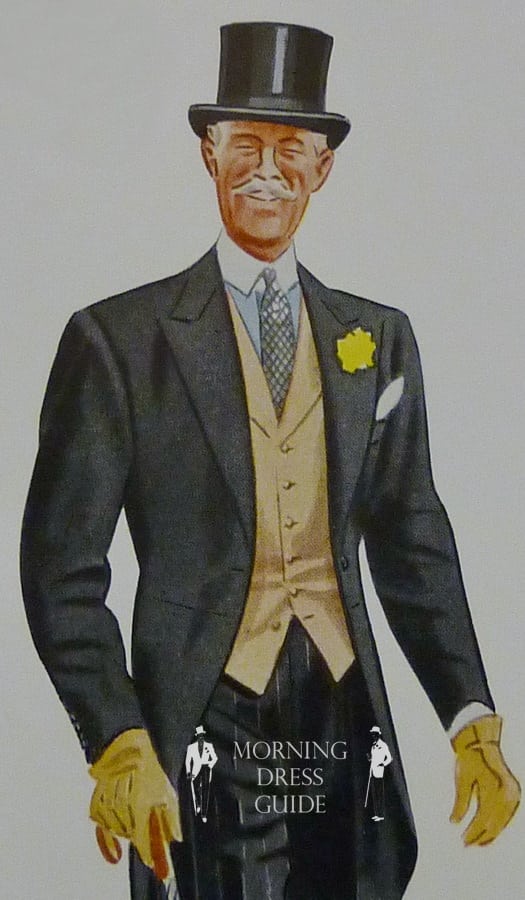
For another casual cool or cold weather wear, colorful knits are easy to find. In the image below, imagine the same sage green suit with a white shirt and no vest. The purple tie would still show some panache, but the outfit would not have the same richness without the blue shirt and orange knitted vest.
Your vest can also act like a dividing line, which lets you wear a tie that is the same color as your jacket without it looking boring, and if your tie and jacket color are slightly off from one another, the vest tricks the eye into not noticing the difference.
3. Switch Out Your Suit for a Combination
Part of the ease of a suit is its uniformity: you don’t need to worry about coordinating the top and bottom of your outfit. Yet, many men prefer an odd jacket and trousers to a suit in part because it opens the door to more color combinations. In summer, you can go all out and try bright chinos or go-to-hell pants, and in winter, colorful corduroys.
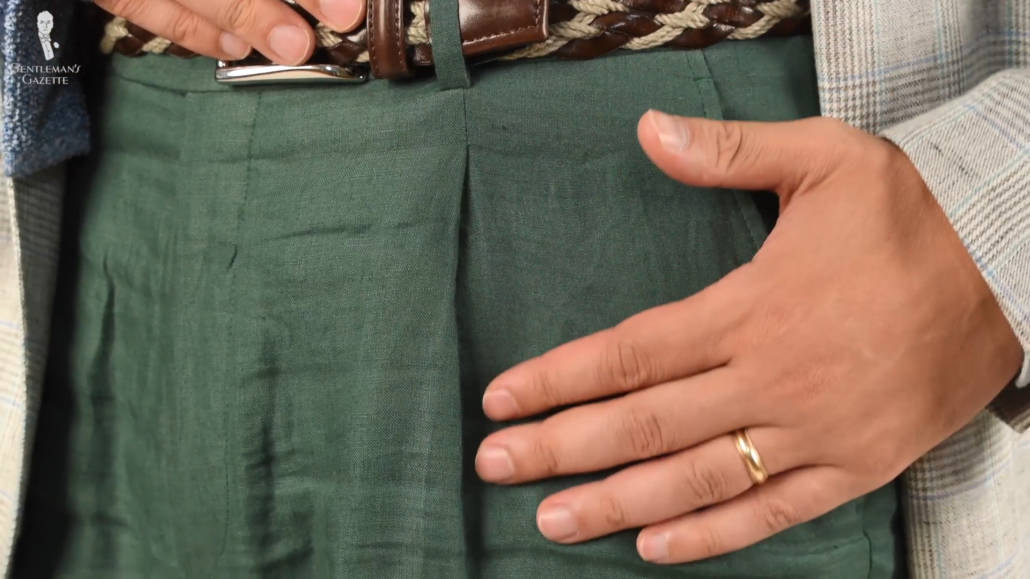
On the other hand, the added variable of different colored pants can create the temptation to over-match by trying to match a solid tie to one’s pants. This can be done, provided the tie is very nearly or exactly the same color, or if the items are similar enough in color but different in texture (like a grenadine tie with worsted wool trousers).
This technique, however, isn’t particularly creative and can make you look like you’re trying. Therefore, you might prioritize wearing a tie of a third color: consider a maroon tie with a navy sport coat and gray pants, for example.
4. Don’t Forget Your Feet
Colored shoelaces are an overlooked means of adding a single pop of color that ticks all the boxes: it’s quick, cheap, and unique. For around $10, which is cheaper than any other menswear accessory you can think of, you can increase the colors you wear. Just make sure you know how to lace your shoes.
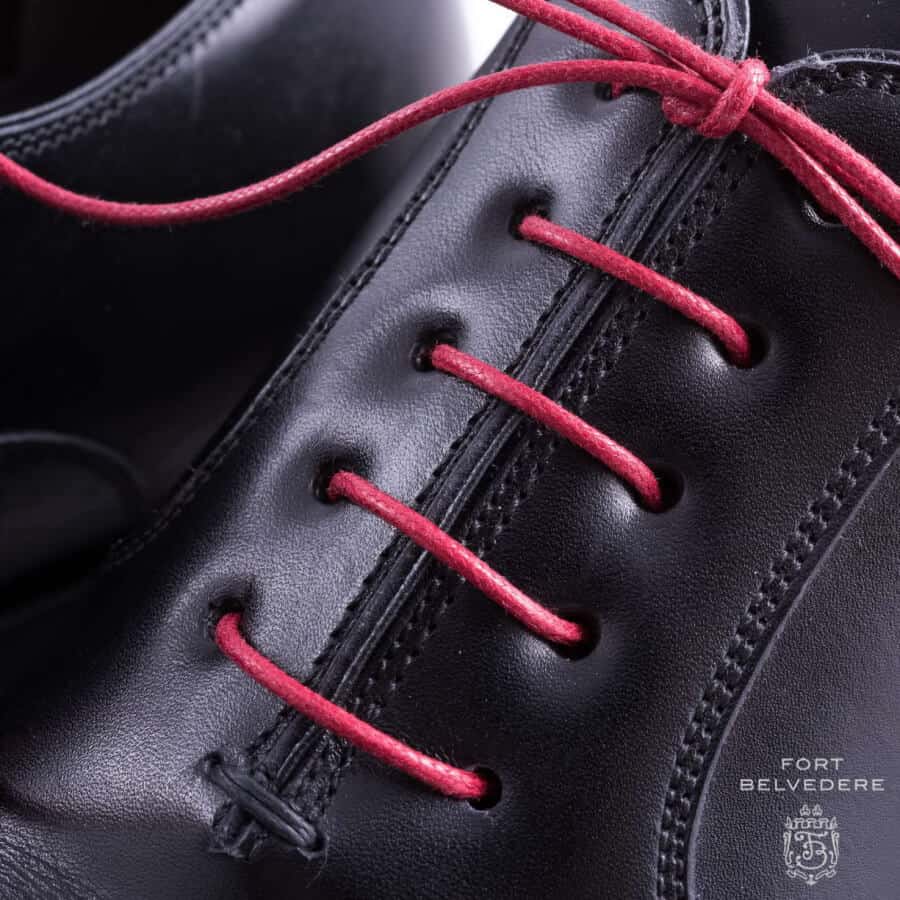
If you are in the market for colorful shoelaces, look no further than the Fort Belvedere shop. We’ve got numerous different colors and styles for both shoes and boots. So, we’re guaranteed to have something that will meet your needs.
5. Add A Boutonniere
The hole in your jacket lapel is meant to be filled, and a boutonniere flower is a perfect choice to do that while adding a stylish pop of another color. If you’re wearing a navy suit with a soft yellow tie, why not introduce a lilac or light blue flower?
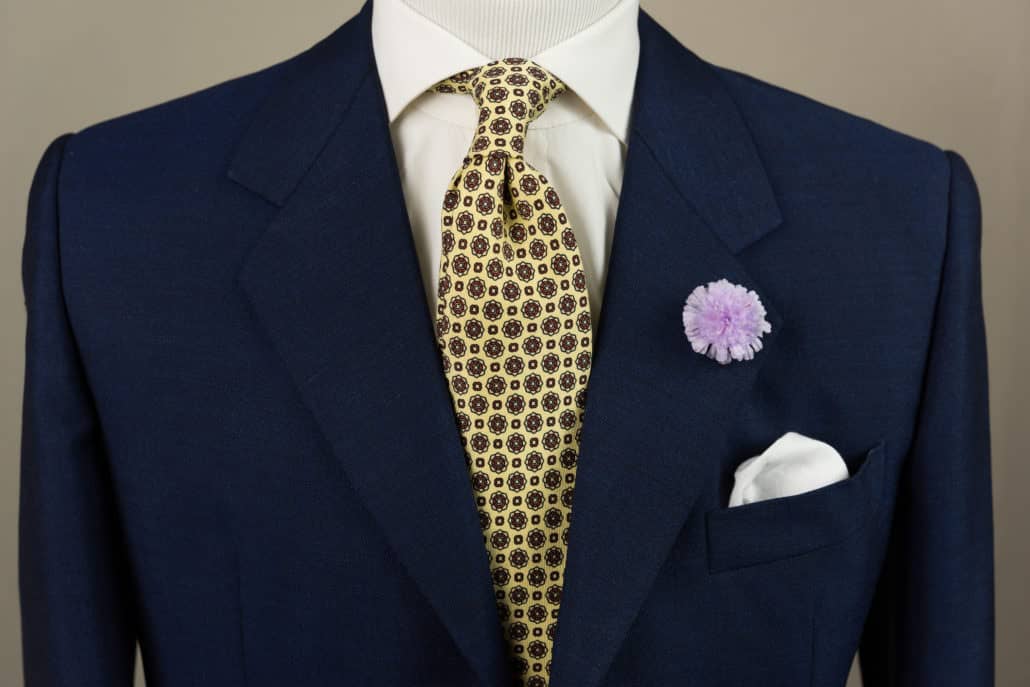
6. Add Several Colors at Once with Patterns
The next step is to add multiple colors at the same time using one article of clothing. By using a patterned garment, you’re automatically going to be introducing more richness and complexity into your outfit than you would simply by just relying on different solids.
6.1. Necktie
A foolproof method to do this is to replace a plain tie with one that contains stripes or a repeating geometric motif. The elements that make up the pattern have to be a different color in order to be visible and often include multiple tones. The beauty of a patterned tie is that it can act as a bridge between the other pieces you are wearing.
In the image below of Raphael, the red tone of his tie works with his trousers, while the lighter stripe pattern coordinates with his gray jacket. The presence of a pattern also breaks up the ground color and therefore de-emphasizes any variation between the main color of the tie and other elements, like the trousers. Therefore, an exact or precise color match matters less for coordination.
It’s equally possible when wearing a patterned tie to use the pattern to introduce an additional color. The base tone of the tie can match your jacket while the geometric motif adds one or more colors you don’t yet have on.A classic example is the classic maroon, navy and gray grenadine striped tie. You could wear this with a gray suit and add two new colors or with a navy blazer and gray pants, making maroon your added color. Another example would be a taupe jacket.
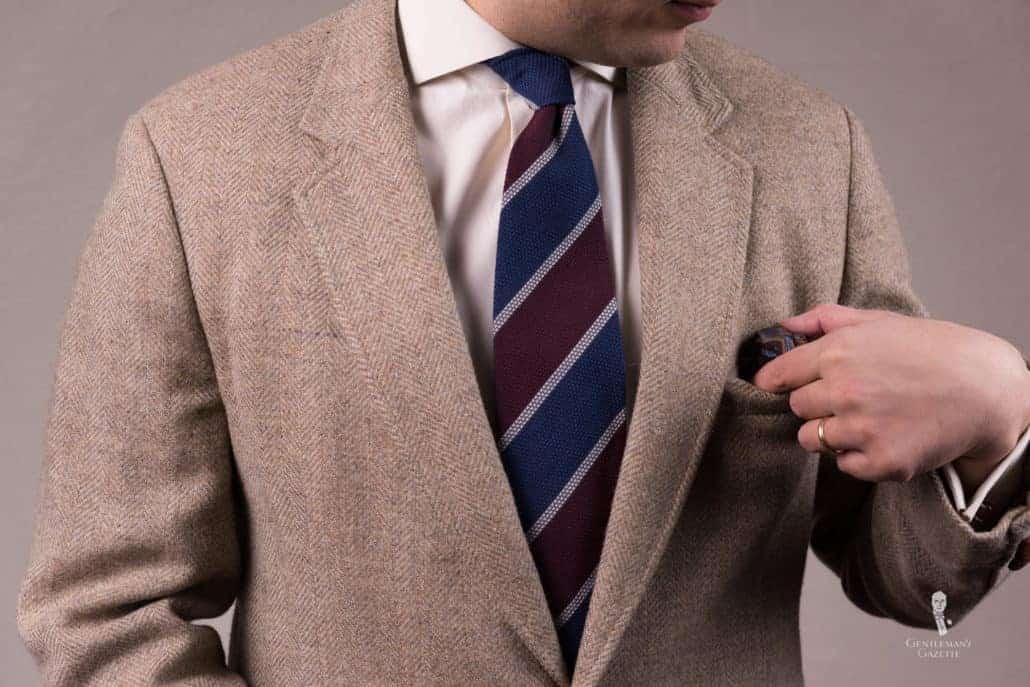
Small repeating geometric patterns on a tie are also fantastic because they often include multiple accent colors. For example, the one below from Fort Belvedere contains green, sky blue, orange, and red, so you’d be adding touches of up to four colors with just one tie.
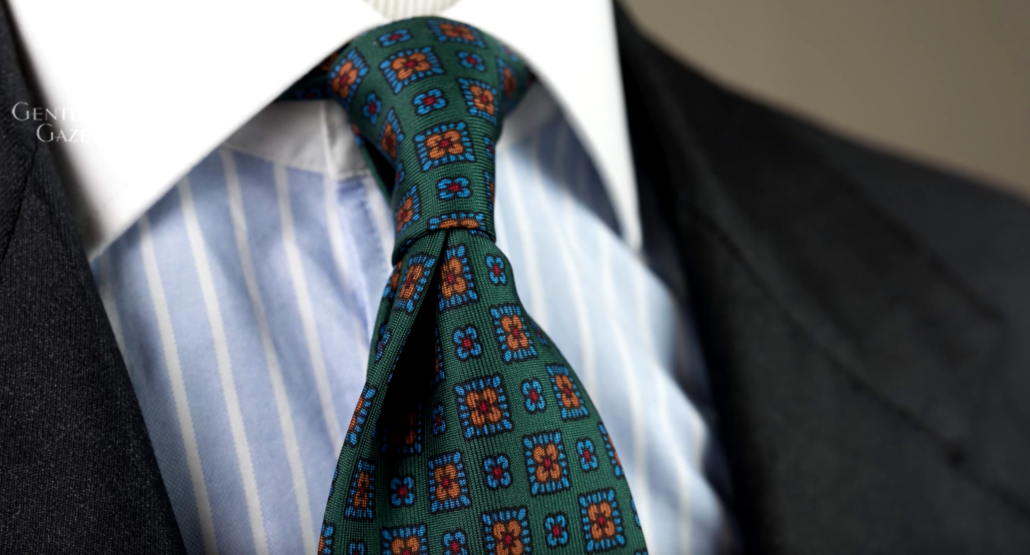
If you want a more casual tie that provides an infusion of several colors at once, try a two-tone changeant silk knit Fort Belvedere. This is made up of two different colored yarns, such as brown and gold or blue and light blue, knitted in such a way that the tone looks like it’s changing depending on the light and viewing angle (thus the French term “changeant“).
Mottled knits are a variation on this, mixing two colors. You can also find slubby shantungs that have secondary shadow colors, giving you multiple subtle tones in one tie.
6.2. Pocket Square
Accessories as a whole are a safe way to add multiple colors at once because you only get them in tiny doses. While you can add just a single new color with a pocket square, one with a pattern will give you the most bang for your buck, packing more color than any other item you can wear.
For example, a paisley pocket square like the one pictured below contains at least eight different tones, but because they’re in pastels and incorporated in a small pattern, none of them are overwhelming.
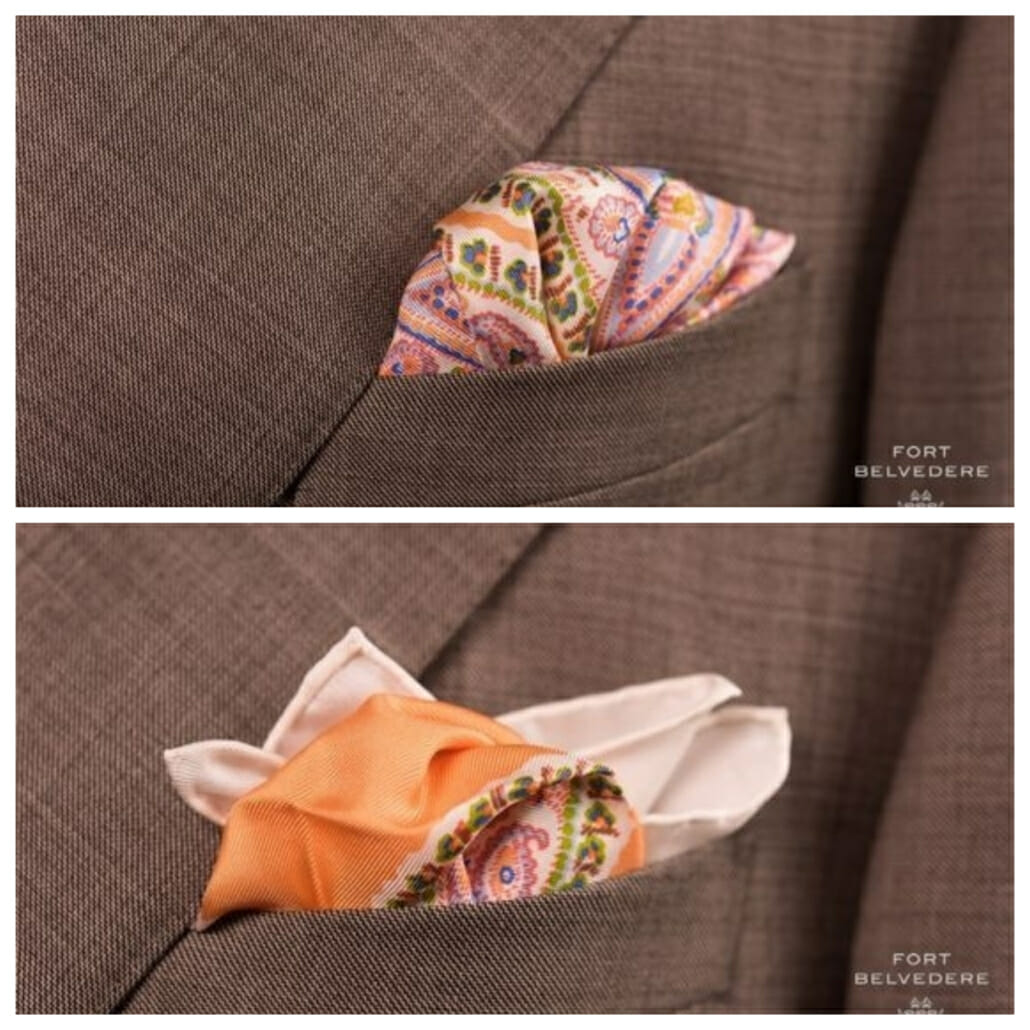
Moreover, even if a hankie contains a complex paisley pattern with a dozen of different colors, you can adjust how it sits in your breast pocket, using different folds, to accent different colors. Using a single pocket square as an example, you can see how a puff fold accents the pink color more, whereas showing the edges further accents the orange.
Pocket squares afford even greater freedom than ties when you want to add color because they are expected to differ from the rest of your outfit. Beginners to men’s style often commit the faux pas of buying matching pocket square and tie sets, but the true connoisseur knows that the handkerchief is the place to introduce an additional hue; it should never be too “matchy.”
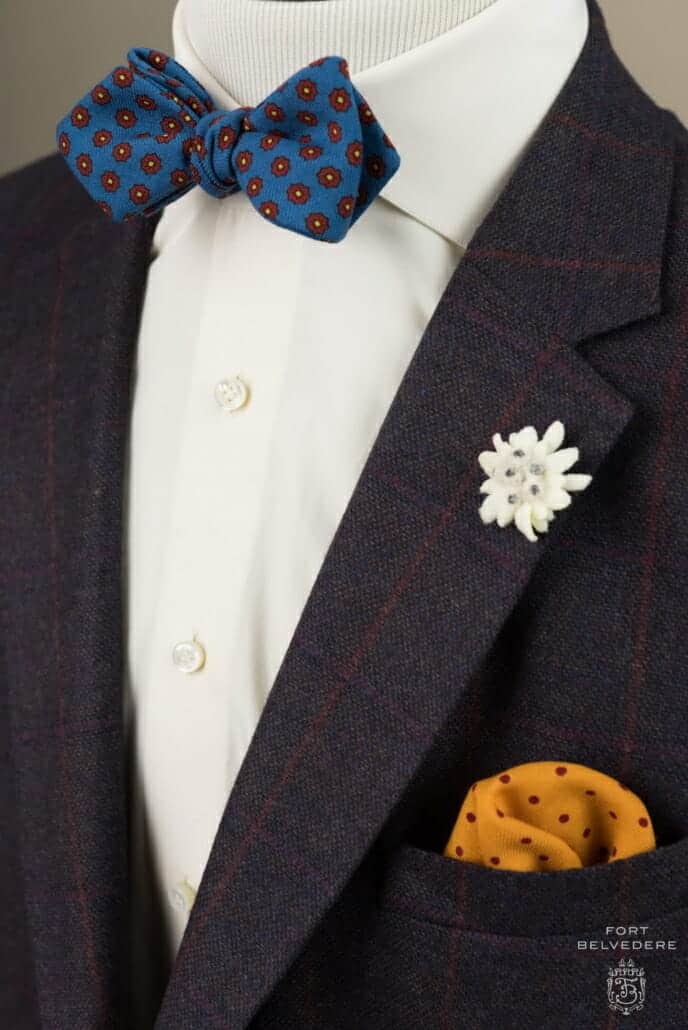
As an example here, the pocket square repeats both the red and gold of the bow ties patterned motif, as well as the red of the jacket’s over check. But, at the same time, it’s accenting gold more than any other color.
6.3. Scarf
Scarves and pocket squares have a lot in common, and the former can be considered, in some ways, larger versions of the latter. However, with a scarf, whether silk with a printed pattern or solid cashmere, you’re getting a stronger effect, so consider it an accent and surround the scarf with subdued-colored garments, such as your overcoat.
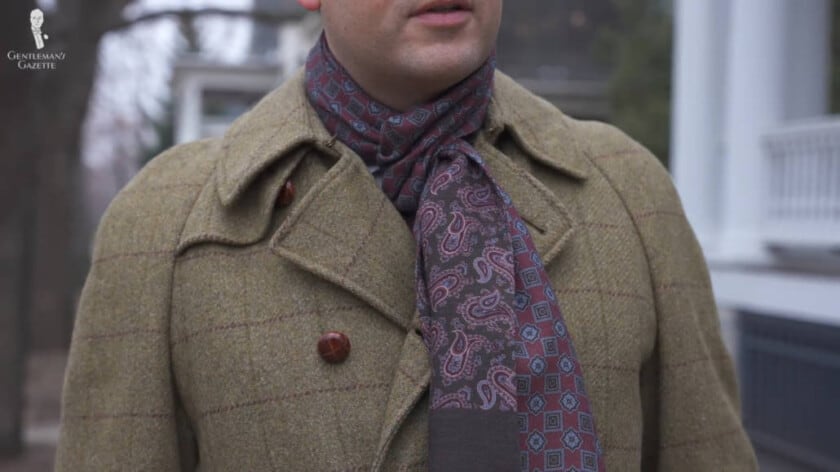
6.4. Tattersall Shirt
Going beyond accessories, an underappreciated technique for adding multiple colors at once is a tattersall shirt. The tattersall pattern is made up of two or more different complementary colors. In the example below from Cordings in the UK, there are actually four different colors–pink, purple, blue, and black–skillfully combined.
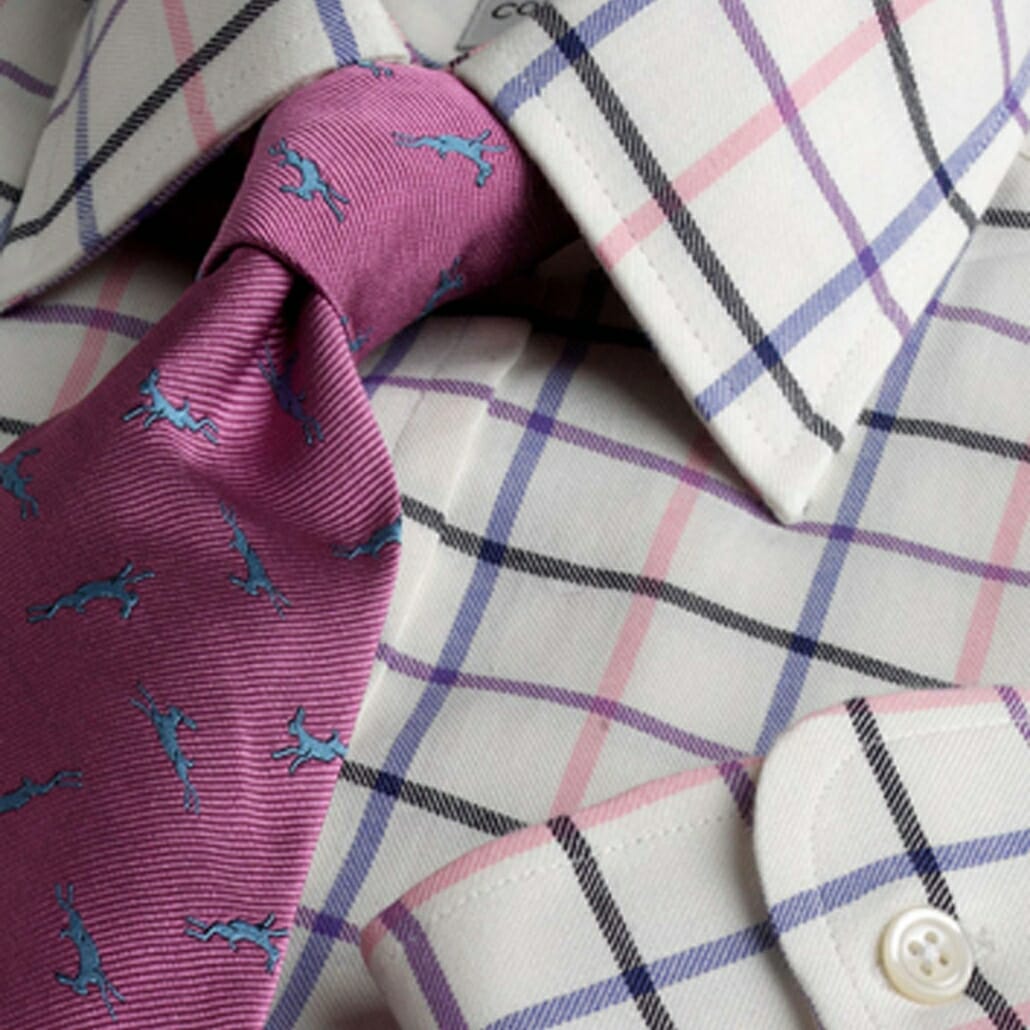
Tattersall is versatile enough to wear in most business settings, providing an understated but clearly apparent injection of color. You can find multi-colored striped shirts too, but they can risk being too loud and look more casual than a fine grid. So, we would recommend that you incorporate them more into business casual ensembles or those even more casual than that.
6.5. Patterned Waistcoat
We’ve mentioned solid waistcoats above, with an emphasis on knits, but the traditional odd waistcoat is supposed to be one that displays a strong pattern. If you have a solid shirt on, you could make your vest the tattersall. Another thing layering this way with a waistcoat achieves is that it gives you more opportunities to play with colors. Your waistcoat can act as a bridge because it can coordinate with a color in your tie, in your jacket, or both!
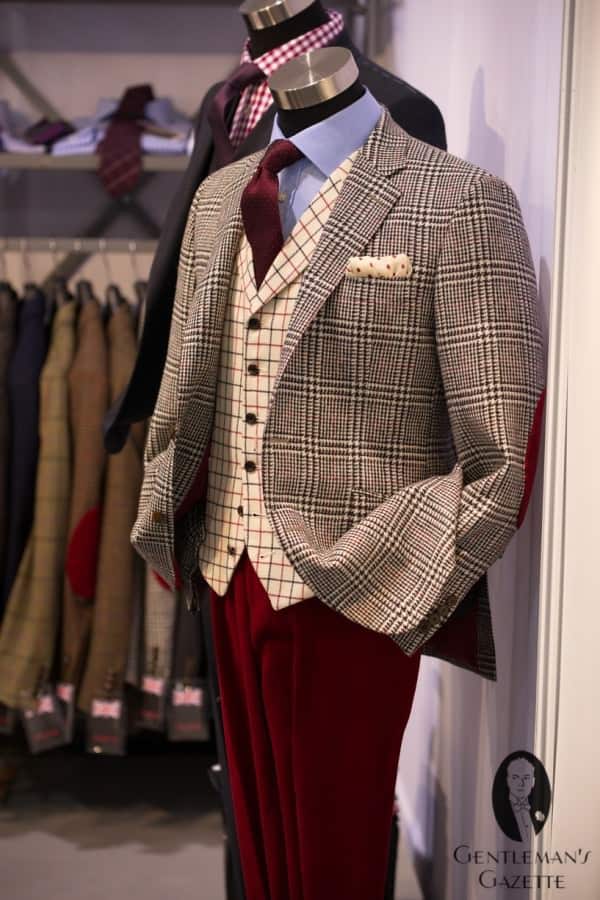
As an example, consider the checked waistcoat from Chester Barrie above, which manages to pull in the buff tones of the pocket square, the red of the trousers, and the blue of the shirt. Red can also be found in the pocket squares, polka dots, and necktie. The pattern in the jacket further reinforces the color feel while also adding more playfulness.
6.6. Tailored Jacket
For your jacket layer, an overcheck is your friend. This is a windowpane grid in one color laid over another plaid pattern. The most famous is the Prince of Wales check, which, by definition includes a glen check in one color over which there is a grid of another hue.
For instance, you might find a grey Prince of Wales with an overcheck in sky blue. Just like that, by wearing one of the classic menswear patterns, you have an additional accent color. You can then coordinate accordingly with the colors of your tie and perhaps a vest.
6.7. Socks
The crazy socks trend seems to have reached a peak a few years back, and it’s not one we’ve really gotten behind, but just because we don’t recommend wearing socks with pizzas or dinosaurs on them, doesn’t mean that we advocate just for sticking with solid socks.
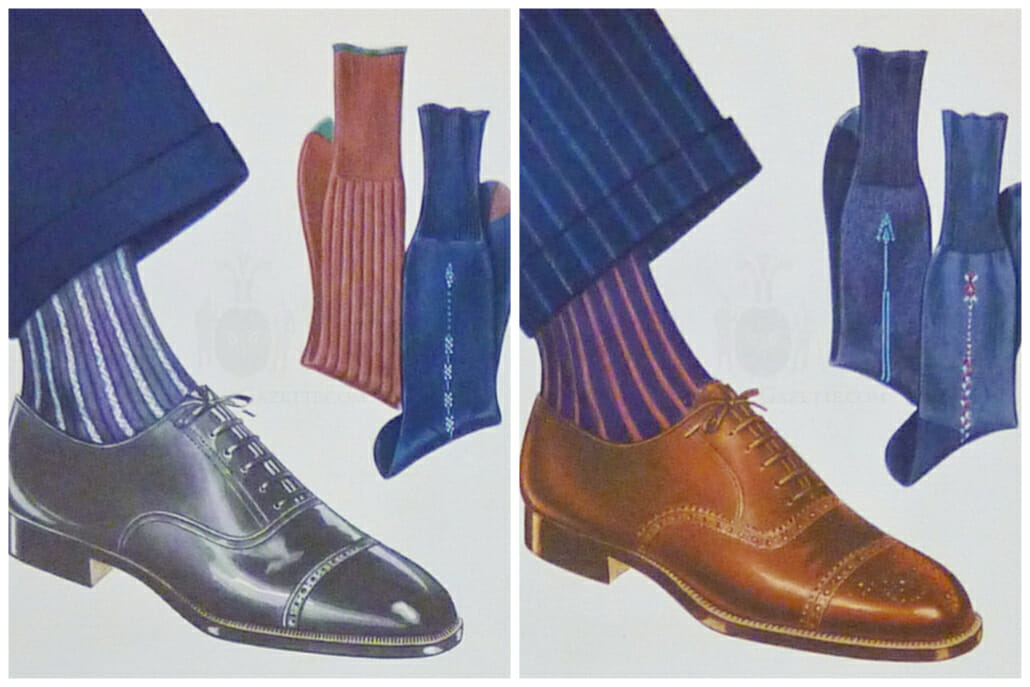
You can wear socks in various accent colors, and especially ones that show some pattern, to amp up the number of colors you’re wearing in one step. It’s not just a trendy move either as you can find a variety of colored and patterned dress socks in vintage apparel arts illustrations from the 20th century.
One option to instantly incorporate two colors is shadow-stripe socks, which have one main color along with a second “shadow” color in the ribbing stripes.
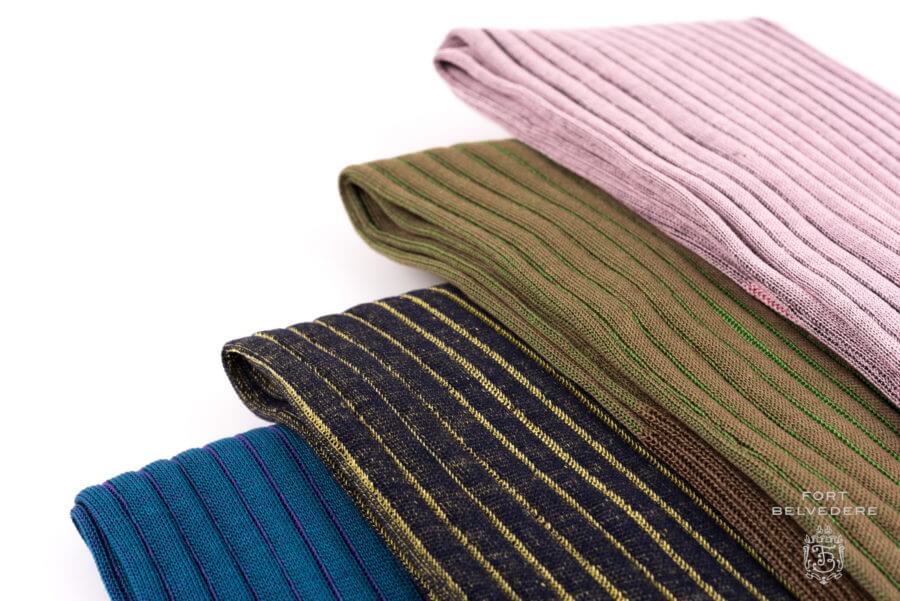
If you want even more subtlety, try socks with clocks (the name for the pattern running down the side) such as a conservative charcoal sock with burgundy and white clocks. Of course, we offer both shadow-striped and clock pattern socks in the Fort Belvedere shop along with our new two-tone solid designs, which also feature multiple colors.
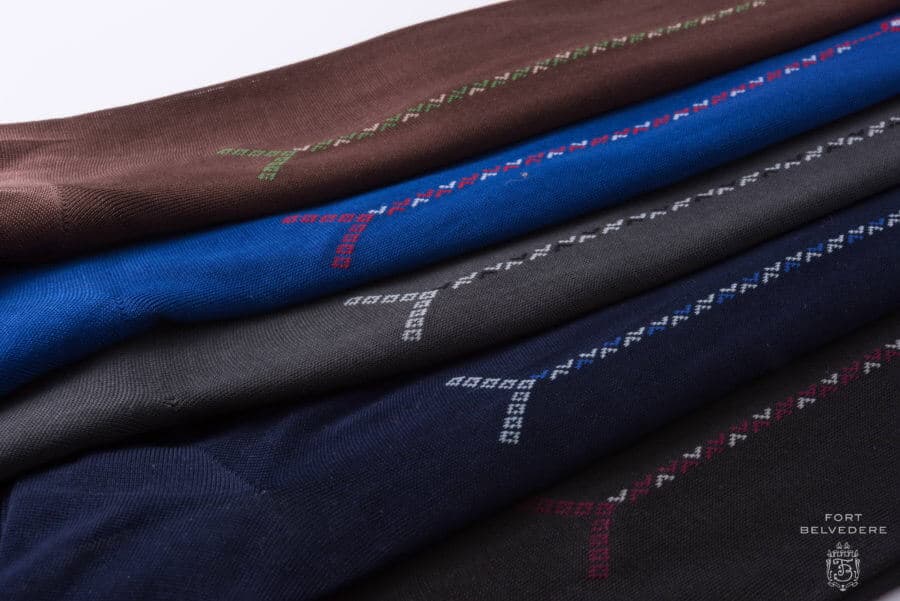
A Note on Neutrals
If you’re wearing any neutral tones, such as brown, beige, khaki, various shades of gray, black, navy, or other shades of blue, be aware that these are easy bases for you to add almost any other color to.
This is true even if you are wearing a garment that features a pattern in neutral colors, such as this gun club check jacket, which features blue and brown tones. It isn’t overwhelmed by the addition of the red in the tie.
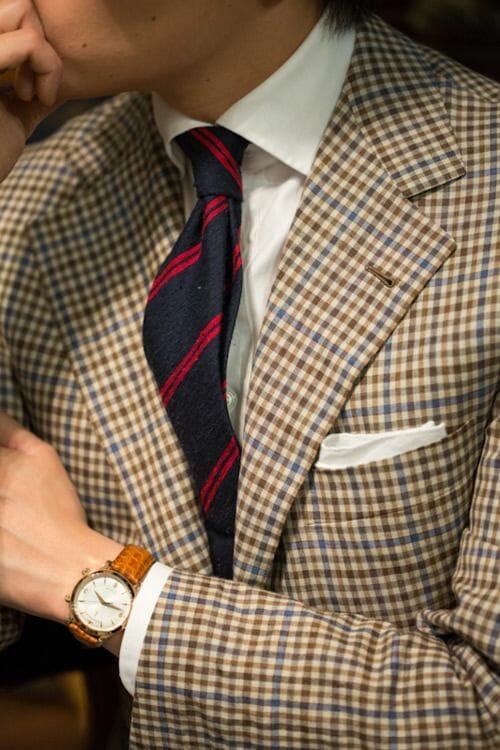
Conclusion
However, adding one other yet unrepresented hue is easy and shows your stylistic expertise. Of course, restraint and careful consideration should always be part of a gentleman’s sartorial game. Pick and choose where you want to add your colors and how far you want to go.
It’s not likely that you’ll wear colored shoelaces, bright socks, go-to-hell pants, and an orange knit vest at the same time. Think of the ideas in this article as a buffet of options for you to choose from. Just don’t overload your sartorial plate!
Outfit Rundown
I’ve put together an outfit that is attempting to illustrate many of the principles we’ve discussed. The principal accent color of my outfit is the blood orange of my v-neck sweater, which is also echoed in the pattern of my pocket square as well as my tattersall shirt.
My principal accent color today is a blood orange, which can also be found in the patterns of my pocket square and my tie. as well as in the tattersall pattern of my shirt.
Other colors featured in that tattersall pattern are blue, green, and purple, which are also all found elsewhere around the outfit. Green is found in the bow tie, pocket square, and socks and purple is also found in the pocket square and socks, as well as my cornflower boutonniere. Blue is admittedly playing a bit of a background role in the ensemble. But, there are some blue tones in the indigo of the pocket square and the cornflower and, indeed, this shade of cornflower was historically referred to as blue. My camel hair sport coat is acting as a neutral to ground the outfit somewhat as are my plain brown trousers.
Though, they do contain a warm undertone, which serves to harmonize with the orange in the outfit.
My chocolate brown suede Oxfords are also grounding the outfit. Though, I’ve inserted into them some tan colored laces from Fort Belvedere to provide an additional pop of color and, of course, you can find all of the Fort Belvedere accessories I’m wearing, including the shoelaces, socks, boutonniere, pocket square, tie in our shop.
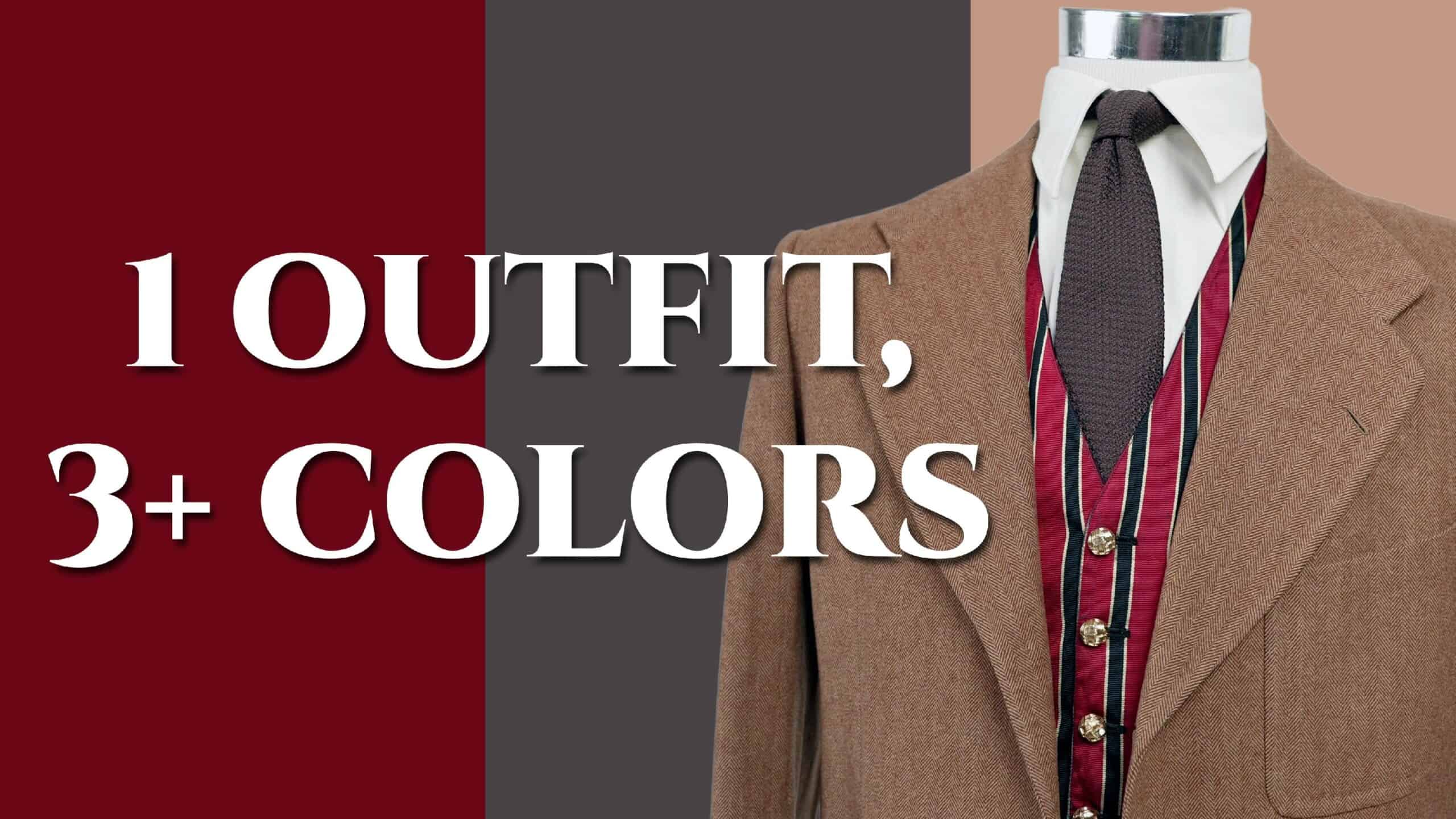

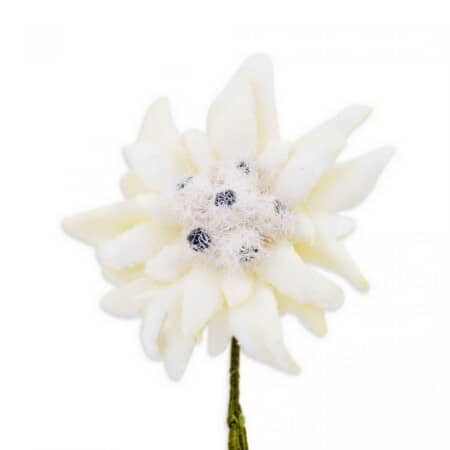
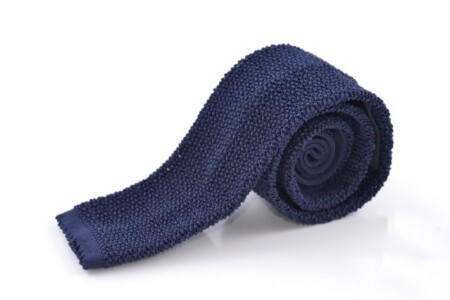
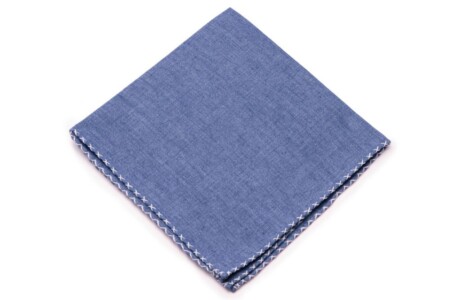
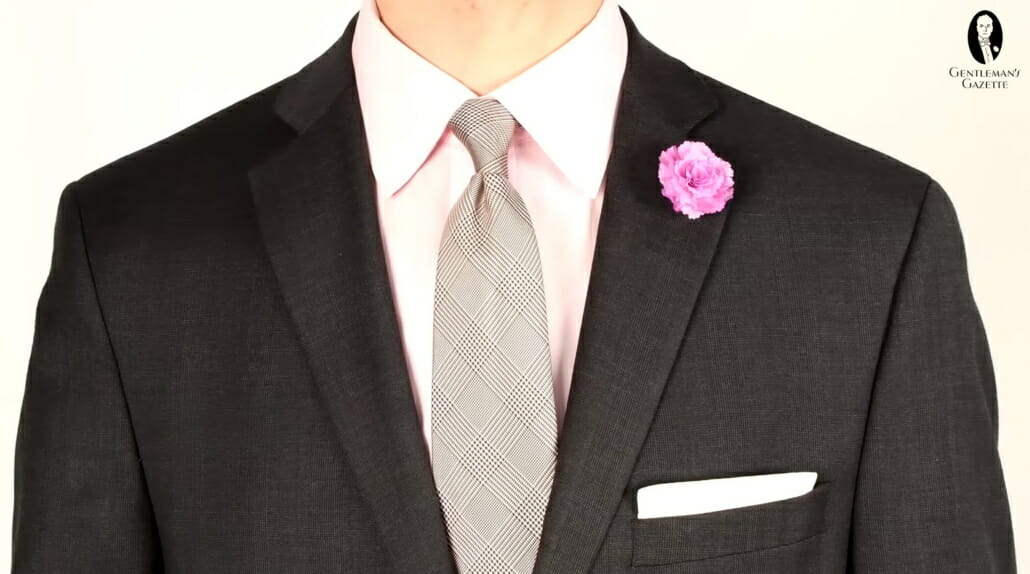
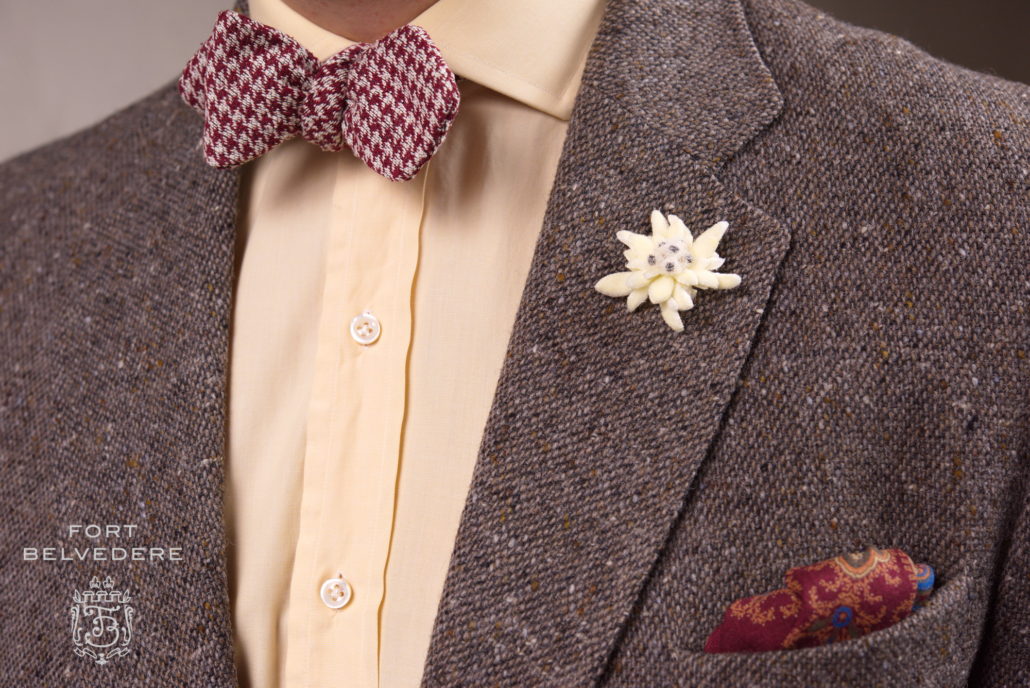
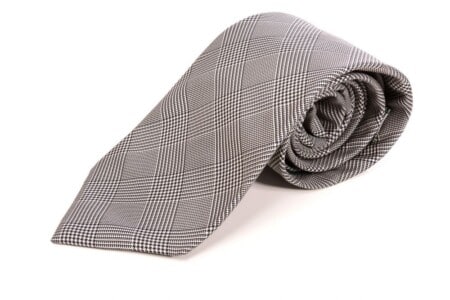
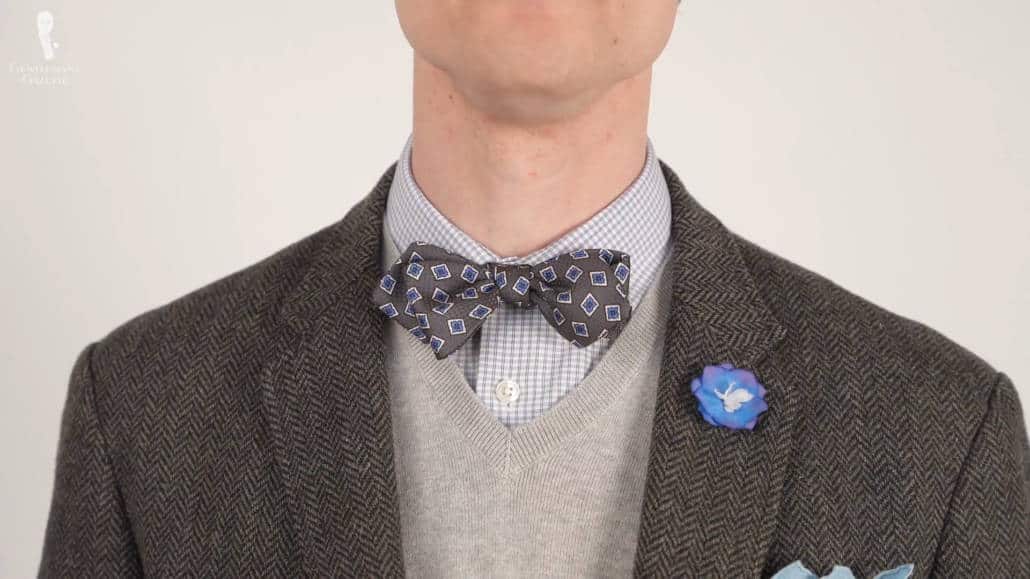
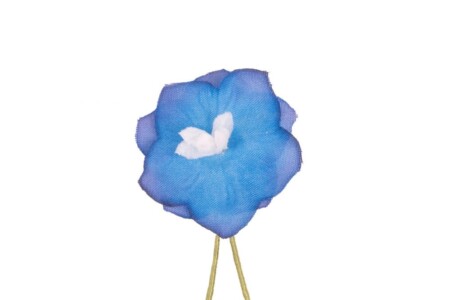
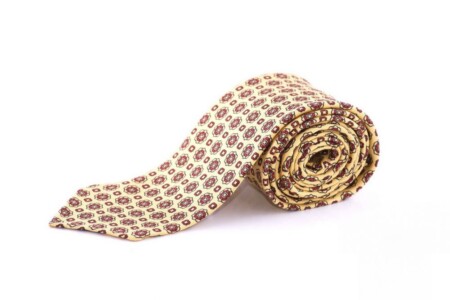
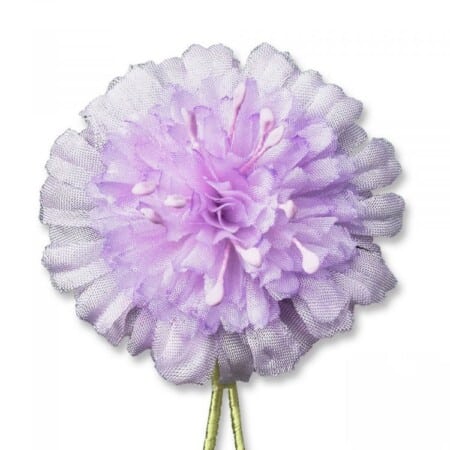
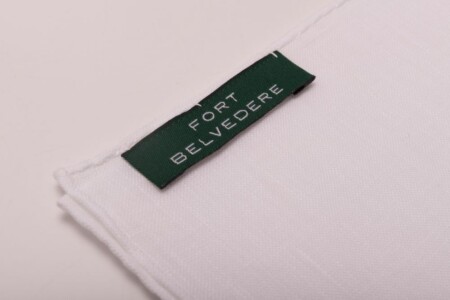
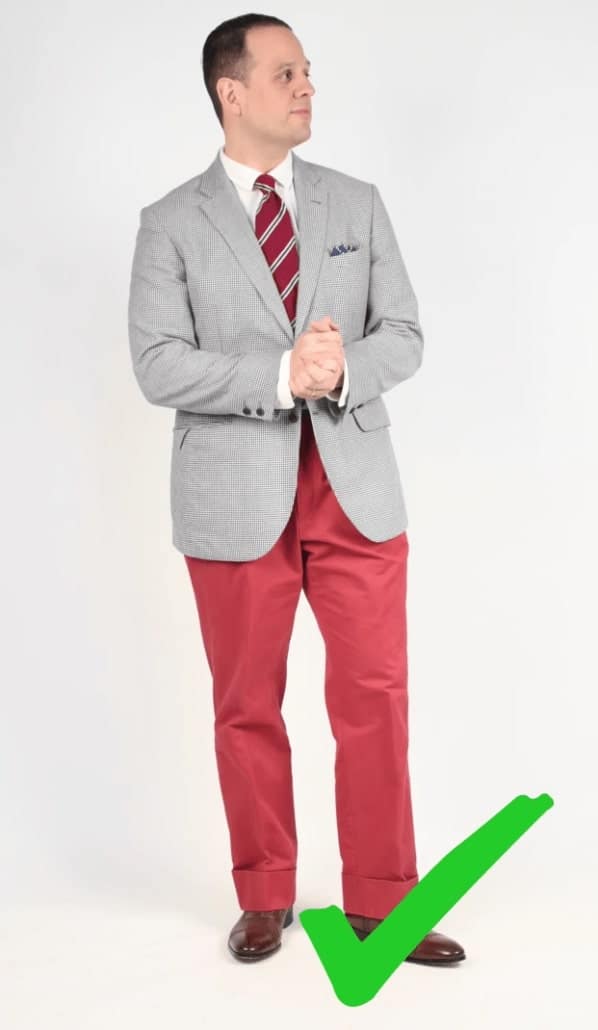
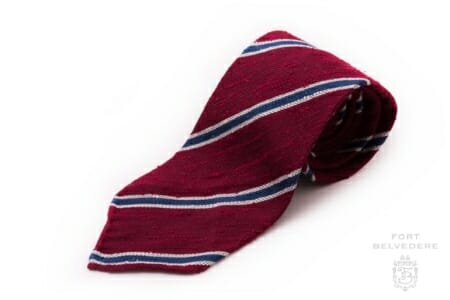
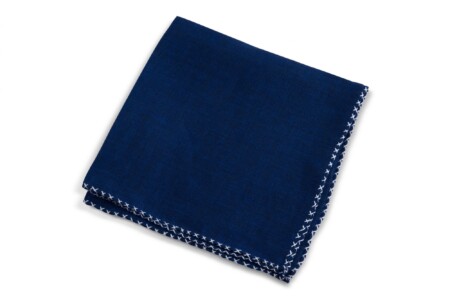
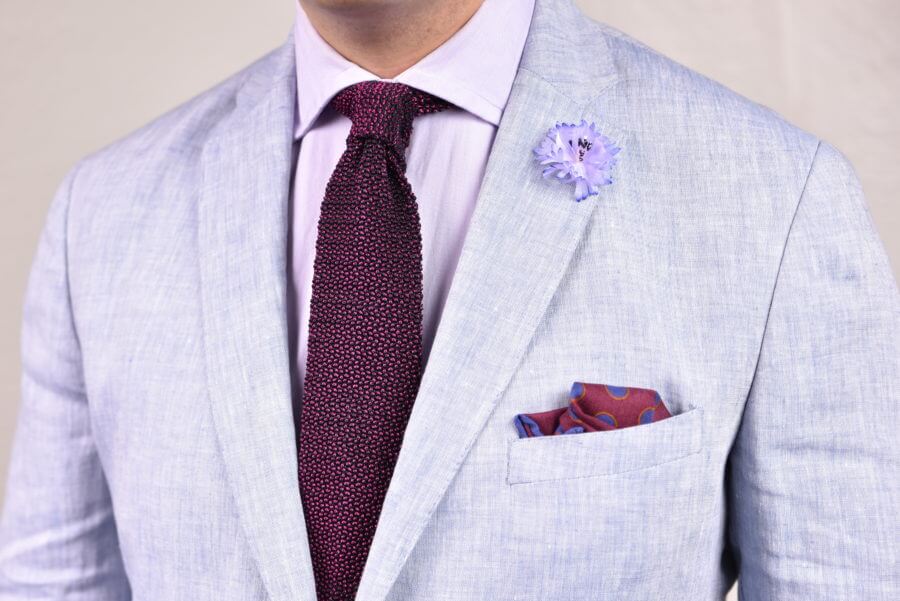
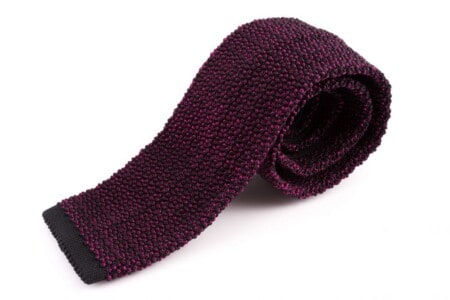
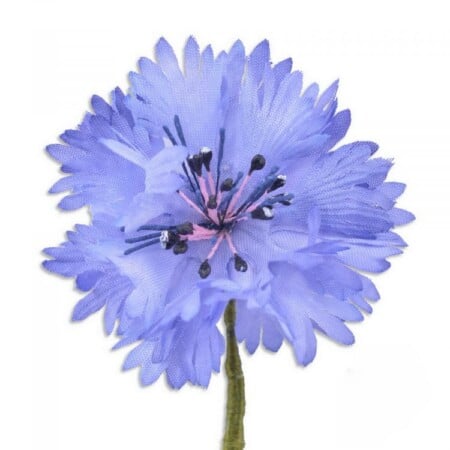
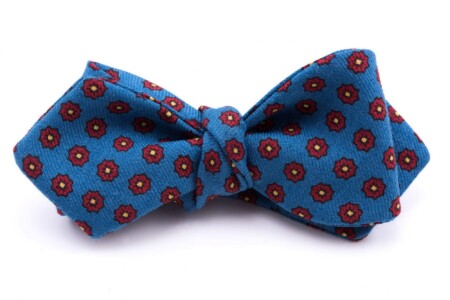
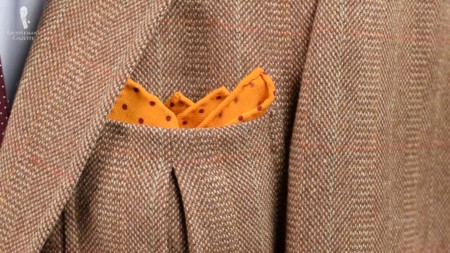
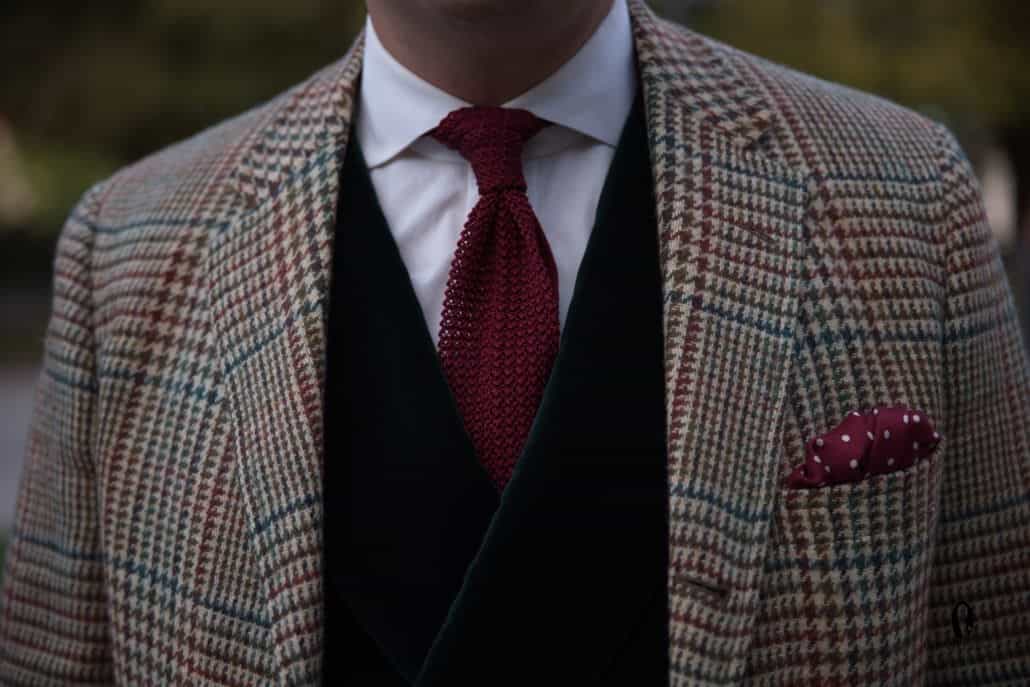
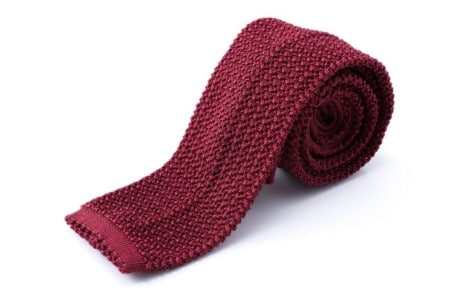
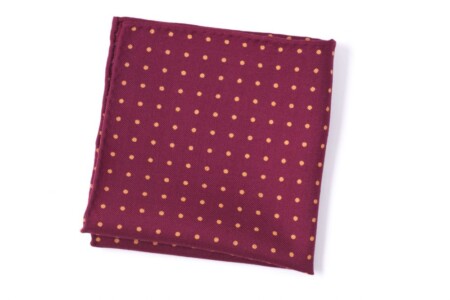
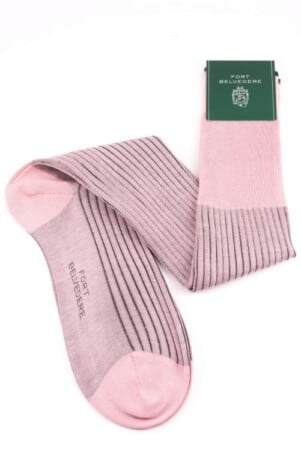
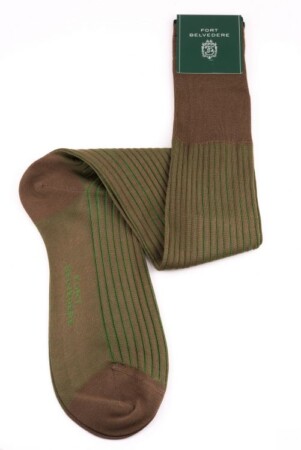
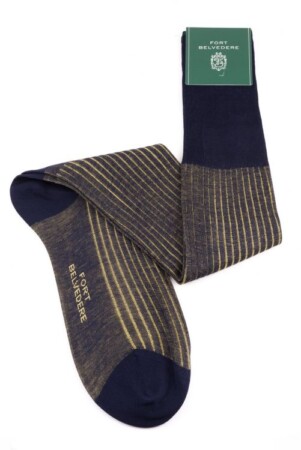
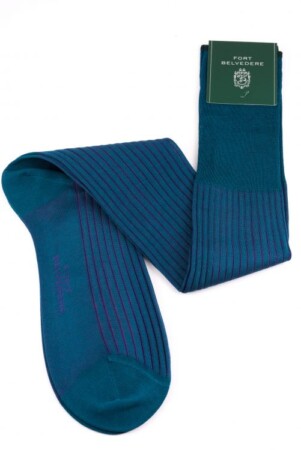
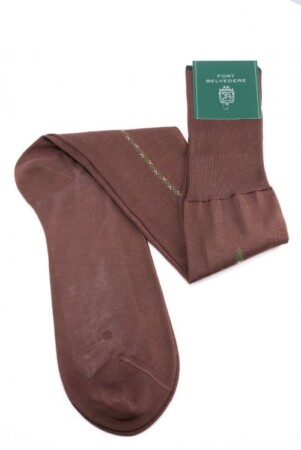
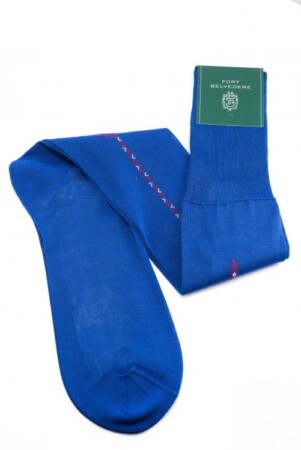
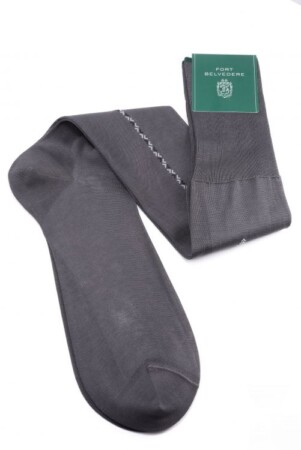
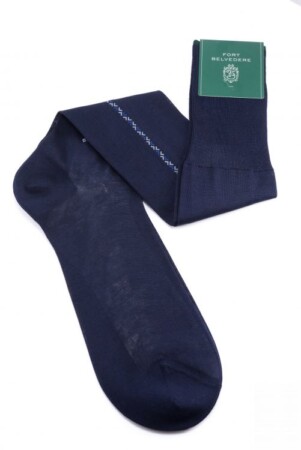
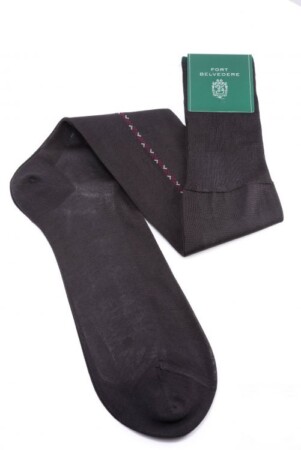
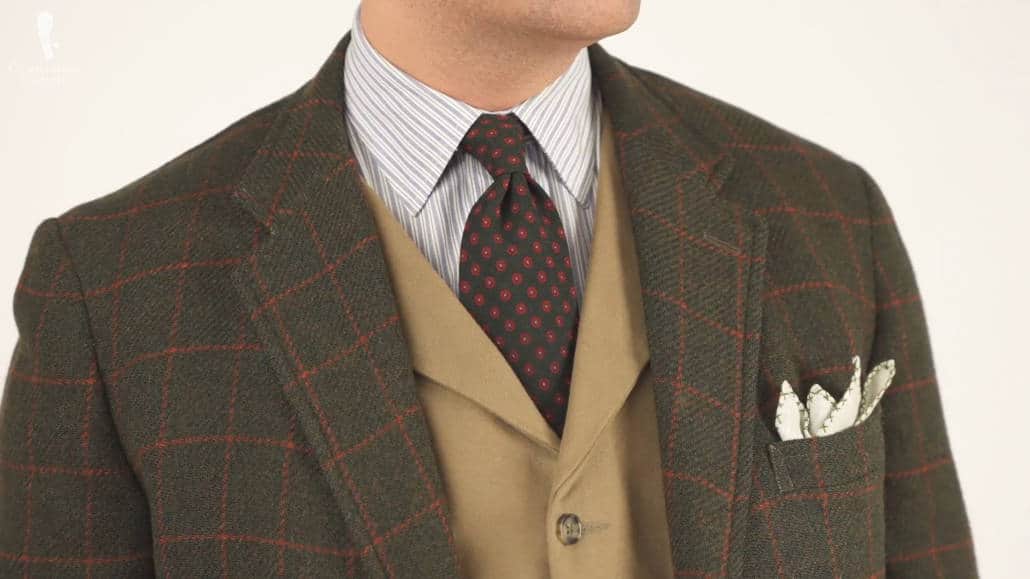
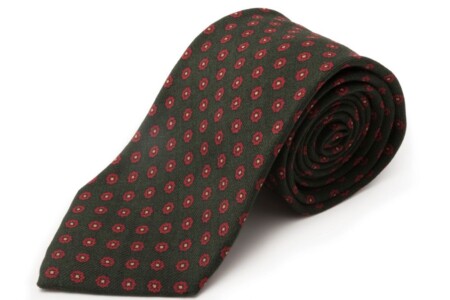
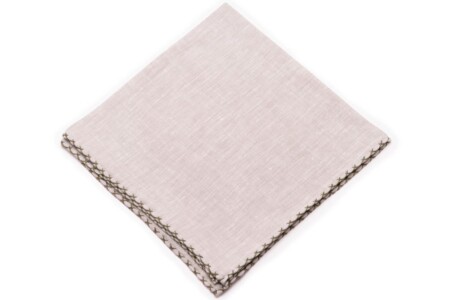
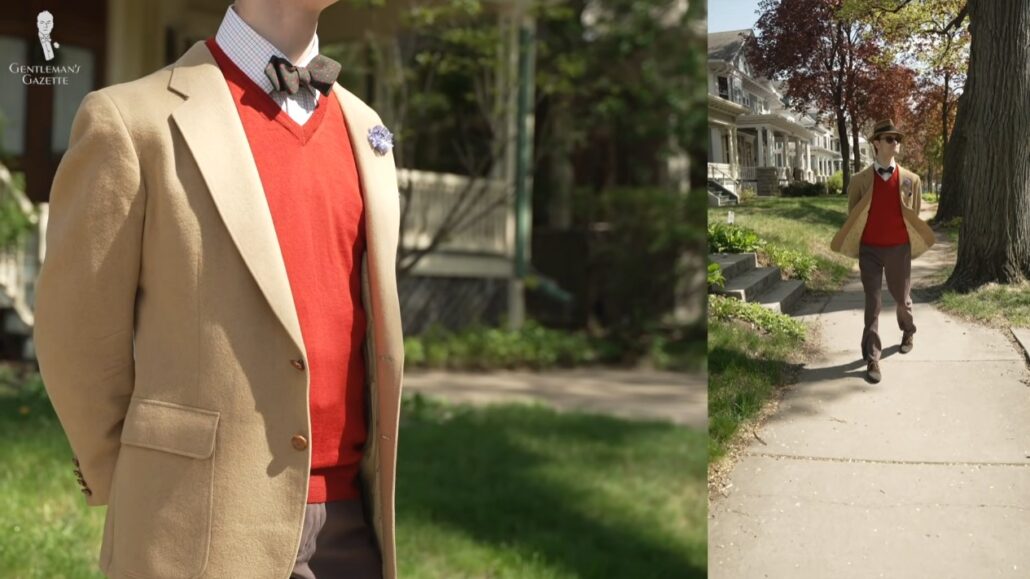
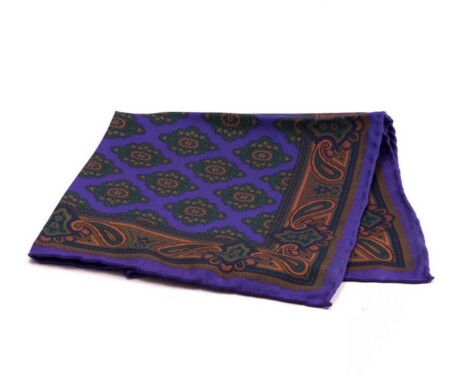
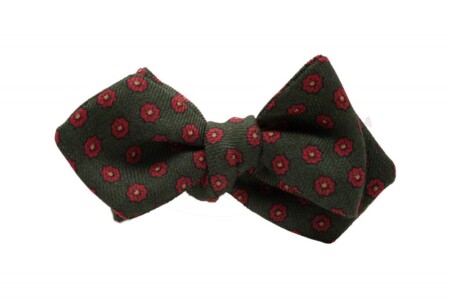
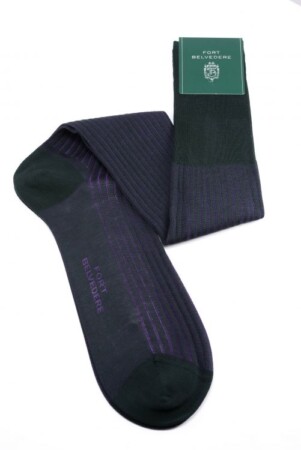
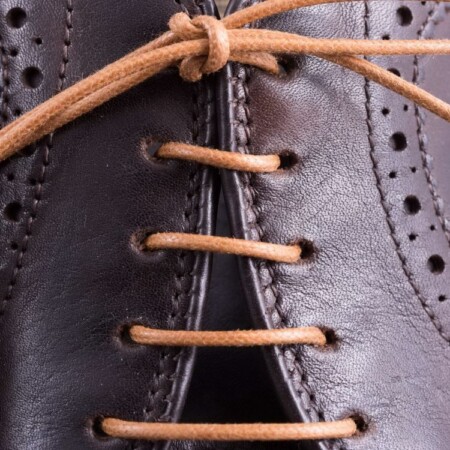
Add a Boutonniere!
if you have got to have a flower in your buttonhole it HAS to be a real one
I have been inundated recently by people trying to sell me real-life looking fake ones and they are!
if you cant do the real thing -DONT!
Dr. Graham, Fort Belvedere has excellent realistic boutonnieres though. The petals are hand-dyed, and they’re made in Germany. I recommend these: https://shop.gentlemansgazette.com/accessories/boutonnieres/
You can see how these boutonnieres are made here.
Blue dress shirts gained a cache when white shirts caused the bright lights required by early television to make a “burn out” on the screen. Wearing a blue shirt at work indicated you had recently appeared on television .
Artificial flowers are in the same class as fancy cuff links, bolo ties, monograms and crests – a high school class.
Get adult!
Fort has some beautiful “bouts”, and quite often the well executed faux is superior to that of mother nature. As to this Joseph and the Technicolor dream coat mixing of sartorial items, sometimes the combos can be “utterly too too” and more like costume than style. Not looking to have Jackson Pollack as my arbiter elegantiarum, although most happy when Sven leads the way.
Love the references to Joseph and Jackson Pollack, Adam.
Thank you kindly.
In reference to real or faux flower boutonnieres, my stylish great uncle always told me the real flower was the only acceptable one, a standard I adhered to until recently. His dictum, of course, was rooted in an era where the artificial flower really did look fake, as opposed to the very realistic items on offer today. I especially like the Fort Belvedere faux flower boutonnieres that stand in for real flowers that would not otherwise be readily available, such as the Edelweiss.
The recent use by young dandies of frankly fake flowers, such as boutonnieres made of men’s suiting material such as flannel, fashioned into rosebuds or other flowers, has brought the issue to a new level. If it looks good and you feel you can carry it off, it’s worth a try. I am an adherent to classical male attire, but not to the point of absolute rigidity to the point of boredom; Pitti would cease to exist if the rules could not be bent with panache. As in every other sphere of life, there should be a finely judged balance…
Perhaps Sven would consider a more detailed article referencing this issue of using real vs. faux flowers as boutonnieres, their history, the practicalities, and their most recent incarnations – no pun intended…
We already have 5 different posts and videos about boutonnieres that answer all of your questions ;)
Personally love to throw on a pastel shirt and then wear a suit with a nice check to it and then pick out the color of the check with my tie.
nice shits i m like the psot
No. 5 – Patterened waistcoat is “SMASHING” Thank You Sir. CMJ
When I see someone wearing boutonnieres, real and fake, (and/or handkerchiefs), I think how tacky they are and the guy is trying to hard.
The only person who could get away with either is Tom Wolfe.
Agreed on the boutonnieres 100%. Unless it’s for some special occasion (like a wedding or a remembrance poppy or something), skip it.
As for the hankies, I’m thinking swords at dawn are in order. At least, for properly done hankies. Do it right (which is surprisingly easy), and it pulls the outfit together. I have seen some applications that missed the mark, however, either from not knowing how to pull it off or just trying way too hard. If you view it as just a small pop of liveliness and character, it works. If you try to make it the centerpiece of your ensemble, it doesn’t.
Good point but I am never going to add handkerchiefs to my wardrobe.
Fair enough. To each, their own. I view it as just another detail of the jacket.
Pocket squares are almost cheating when it comes to easily adding a much-needed pop of color(s). I love ’em. I don’t always wear a tie with my jackets, but I ALWAYS wear a square in it, and the vast majority of my squares are patterned. As was mentioned, the fold can be adjusted a bajillion ways to achieve whatever effect you want to create. I always peruse the pocket square selection at my local haberdashery when I swing through, just to see if anything flips my switch. If I look at one more than twice, I just buy it immediately. I even give them as gifts sometimes (or use them as wrapping for other small gifts).
The vast majority of my shirts are colored and/or patterned. As I don’t always wear jackets (particularly in the summer), they provide plenty of visual interest on their own. When I do wear a jacket, the shirts just give me that extra bit of panache. My jackets (and ties) are usually quite subtle both in color and pattern, like the lovely dark jacket with reddish windowpane and the gray herringbone jacket shown above, so it’s easy for it to not get too busy when I throw on the whole enchilada.
Good article.
I haven’t worn a suit coat, sport coat, or blazer without a pocket square for numerous years. It’s not even an option for me.
Good stuff! Have been enjoying combining up to 4 different patterns/colors with success. Certainly takes a bit of artistry and switching things around. When you get it right it is a fantastic look that always gets a few compliments.
Agree on the boutonniere… Too Much! Weddings and special occasions only.
Great article! May be I suggest Sven grow his hair longer and styled?
If someone asked me this question, I would say that it may look weird. After reading this blog I never knew that the whole outfit can look awesome with these tips. Thanks for such great insights.